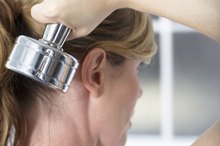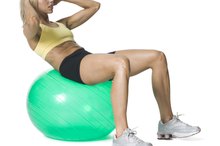What does fact checked mean?
At Healthfully, we strive to deliver objective content that is accurate and up-to-date. Our team periodically reviews articles in order to ensure content quality. The sources cited below consist of evidence from peer-reviewed journals, prominent medical organizations, academic associations, and government data.
The information contained on this site is for informational purposes only, and should not be used as a substitute for the advice of a professional health care provider. Please check with the appropriate physician regarding health questions and concerns. Although we strive to deliver accurate and up-to-date information, no guarantee to that effect is made.
Calories Burned in Plyometrics
Any exercise that quickly and repeatedly stretch, load and contract your muscles is plyometric. For example, when you jump up and down as high as you can or do fast push-ups with a hand-clap between them, you are doing plyometrics. Your aim is to increase muscle power. Plyometric intensity burns up large amounts of calories quickly, according to Sports Fitness Advisor.
Plyometric Intensity
You can increase the intensity of your plyometric workout as your fitness increases with practice 1. You can begin with 30 seconds of each exercise, add speed and explosiveness with each move and increase your duration until the workout raises your heart rate to at least 85 percent of your maximum predicted rate. At this point, if your routine exceeds 20 to 30 minutes, your physiology will be operating aerobically and burning calories derived from your body fat, not only from the sugar circulating in your blood at the time you started your routine, according to Sport Fitness Advisor. Don't forget to rest between sets.
- You can increase the intensity of your plyometric workout as your fitness increases with practice 1.
- At this point, if your routine exceeds 20 to 30 minutes, your physiology will be operating aerobically and burning calories derived from your body fat, not only from the sugar circulating in your blood at the time you started your routine, according to Sport Fitness Advisor.
Plyometric Varieties
Hindu Squats for Weight Loss
Learn More
You can customize your plyometrics to tone and build your lower body or your upper body selectively, but all exercise burns calories and fat from all over your body, not only the muscles you are working on, according to exercise physiologists at the University of New Mexico 2. As a result, every variety of plyometric exercise contributes to your overall calorie-burning success. Lower body plyometrics are suitable for basketball, track and field, soccer, football, hockey and any sport that requires sprinting, jumping or kicking. Upper body plyometrics are useful in basketball, volleyball, tennis and throwing events. Most upper body plyometrics use a medicine ball. For every 3,500 calories you burn in excess of what you eat, regardless of which muscle group you are working on, you will burn up one pound of body fat taken from everywhere on your body.
- You can customize your plyometrics to tone and build your lower body or your upper body selectively, but all exercise burns calories and fat from all over your body, not only the muscles you are working on, according to exercise physiologists at the University of New Mexico 2.
Calorie Burning
Because your body mass is part of the weight you exercise with, larger people burn more calories than smaller people with the same exercise. For instance, if you weigh 125 pounds, one hour of 5 mph jogging will burn 480 calories. At 185 pounds, you will burn 710 calories. One hour on an elliptical will burn 540 and 800 calories respectively, and rope jumping will burn 600 and 888 calories respectively. By contrast, a less plyometric sport like golf, carrying your bag and strolling the greens, will burn only 330 and 488 calories, illustrating the superiority of plyometric exercise in calorie burning.
- Because your body mass is part of the weight you exercise with, larger people burn more calories than smaller people with the same exercise.
- For instance, if you weigh 125 pounds, one hour of 5 mph jogging will burn 480 calories.
Results
Exercises for the Sagittal Plane
Learn More
The benefit of calorie burning with plyometrics is more than weight loss and lower body fat. You will also gain muscle mass, firmness and strength, which add up to a well-sculpted body. The intensity and explosive quickness inherent in plyometric exercises also builds endurance and cardiac fitness.
Related Articles
References
- YouTube: Free Fitness Plyometrics Workout Video
- University of New Mexico: Making Sense of Calorie-Burning Claims
- Harvard Health Publications: Calories Burned in 30 Minutes for People of Three Different Weights
- American Council on Exercise. ACE Personal Trainer Manual, 3rd Edition. San Diego: American Council on Exercise, 2003.
Writer Bio
Walt Pickut has published peer-reviewed medical research since 1971. Pickut teaches presentational speaking and holds board registries in respiratory care and sleep technology. He is a member of the Society of Professional Journalists and the American Society of Business Publication Editors and is editor for "The Jamestown Gazette." Pickut holds bachelor's degrees in biology and communication, and master's degrees in physiology and mass communication.









